We’ve noticed something interesting through helping entrepreneurs at WPBeginner: more businesses are looking to create niche marketplaces like Etsy or Amazon, but without massive development costs.
The good news is that WordPress makes this entirely possible.
After testing numerous marketplace solutions and setups, we’ve learned that creating a successful online marketplace doesn’t require expensive development or technical expertise.
With the right combination of WordPress tools and plugins, you can build a fully functional marketplace that connects buyers and sellers effectively.
In this guide, we’ll show you exactly how to create an online marketplace using WordPress.
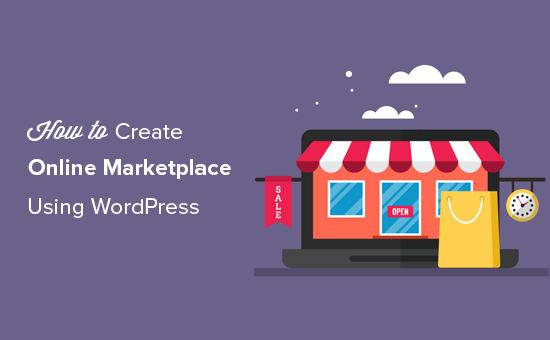
What Do You Need to Start an Online Marketplace Using WordPress?
We’ve worked on many online businesses and know that choosing the right website platform is essential for success. If you’re here, you’re already on the right track with WordPress.
There are two types of WordPress: WordPress.com and WordPress.org.
WordPress.com offers hosting services, while WordPress.org, often referred to as self-hosted WordPress, provides full control and flexibility. For more details, check out our complete comparison of WordPress.com vs. WordPress.org.
We recommend using WordPress.org. It gives you complete freedom and includes all WordPress features right out of the box, making it perfect for building an online marketplace.
To create a marketplace similar to Etsy or eBay, you’ll need the following items:
- A domain name (e.g., wpbeginner.com)
- A web hosting account (This is where your website’s files are stored)
- An SSL certificate (Needed for securely accepting online payments)
- WooCommerce (the best WordPress eCommerce plugin)
- An online marketplace addon
The whole setup can take around 40 minutes. We will guide you through each step in detail:
Ready? Let’s get started.
Step 1. Setting Up Your eCommerce Platform
The first step in launching an online marketplace is securing a domain name and a web hosting account.
We recommend choosing a hosting service that supports WooCommerce hosting since you’ll be using it as your eCommerce platform.
Typically, a domain name can cost around $14.99 per year, web hosting about $7.99 per month, and an SSL certificate around $69.99 per year.
For those just starting out, these costs might seem overwhelming.
Thankfully, Bluehost, an officially recommended WordPress and WooCommerce hosting provider, offers our users a special deal. This includes a free domain, an SSL certificate, and discounted WordPress hosting.

This means you can get started for as low as $1.99 per month.
Once you’ve secured your hosting, check out our detailed guide on how to start an online store for step-by-step setup instructions.
At this point, you should have a WordPress website with WooCommerce installed.
By default, WooCommerce is set up for single-vendor sites, meaning it won’t allow other users to add their own products or services like they can on platforms such as eBay or Etsy.
We’ll show you how to change this setup.
Step 2. Turn Your WooCommerce Site into an Online Marketplace
First, you need to install and activate the WC Vendors plugin. For more details, see our step-by-step guide on installing a WordPress plugin.
WC Vendors is a marketplace solution for WooCommerce. It simplifies building a marketplace website by turning WooCommerce into a multi-vendor website like eBay, Etsy, or Amazon.
Note: There is a free version of WC Vendors available, but we will be showing the features of the Pro version since it has all the functionality you need.
Why We Recommend WC Vendors
- Proven Reliability: We’ve found WC Vendors to be highly dependable for building multi-vendor marketplaces with ease.
- Feature-Rich: Offers comprehensive tools for vendor management, commission tracking, and product listings, giving you full control.
- Scalable Solution: Whether you’re starting small or planning to grow, WC Vendors scales to fit your marketplace’s evolving needs.
See our full WC Vendors review to learn more.
Using WC Vendors, each vendor can sell their products while you control the website as the marketplace owner. You can choose your business model, payment methods, product types, etc.
Upon activation, head to the WC Vendors » Settings page to configure marketplace settings.
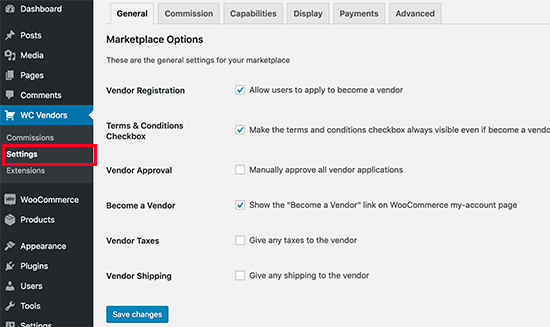
First, you will see the general items. You need to make sure that the ‘Vendor Registration’ box is checked to allow users to sign up as Vendors on your website.
You can review other items on the page and then click the ‘Save Changes’ button to store your settings.
Next, click the ‘Commission’ tab to set a commission rate for vendors on your website. This is the amount you’ll pay the vendor for each sale.
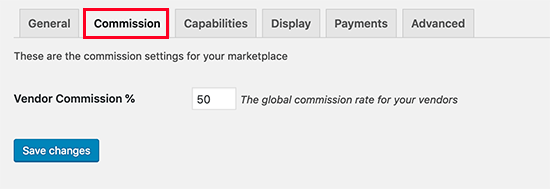
Note: The global commission rate can be overridden for individual vendors and products.
Next, click on the ‘Capabilities’ tab to set sitewide rules for vendors. These settings have three sections.
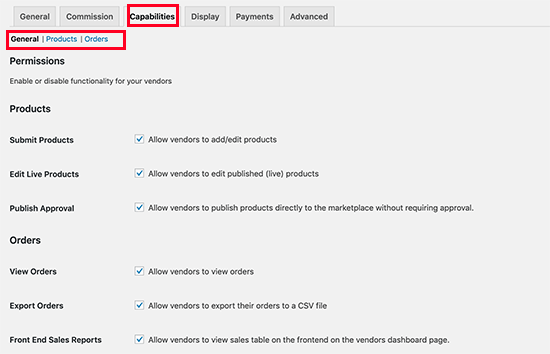
The general capabilities include allowing vendors to view and edit products and orders. The default options would work for most sites.
Next, switch to the ‘Products’ section. From here, you can select which types of products vendors can add. For example, you can limit vendors to only adding digital downloads or physical products.
You can also select which data vendors can see and use on the ‘Add Products’ page.
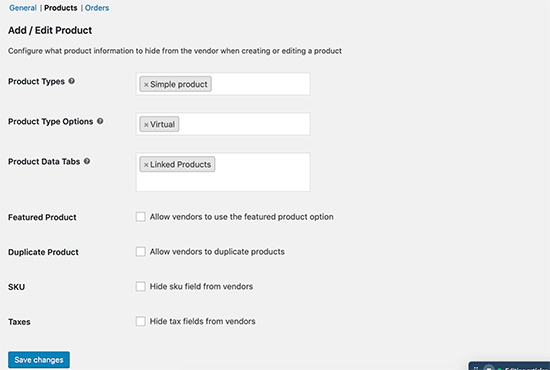
Lastly, switch to the ‘Orders’ section under ‘Capabilities.’
Here, you will select the information vendors can see about the orders.
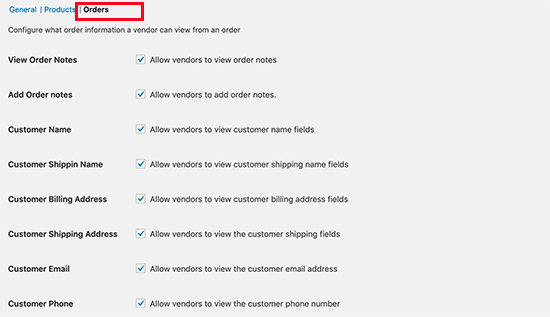
After setting up the capabilities, it is time to set up marketplace-related pages on your website.
Switch to the ‘Display’ tab under plugin settings to set up pages. You can simply go to the Pages » Add New to create a new page for each item and add the shortcode displayed in the settings to the page’s content area.
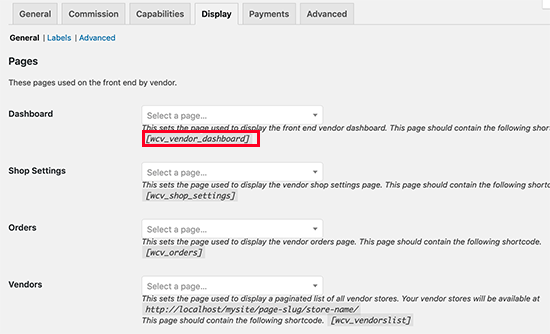
After creating all the pages and adding shortcodes, you can select them here.
On the same page, you will also find the ‘Store settings’ option below the pages. This is where you can select a prefix to use in Vendor shop URLs, allow them to set custom headers for their shop pages, and use HTML in shop descriptions.
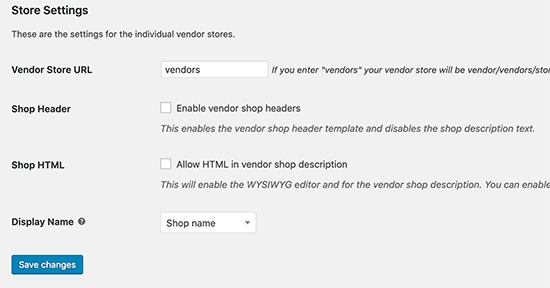
The next step is to set up payments for your vendors. Most marketplace websites set a minimum threshold for their vendors and pay them monthly or weekly.
We recommend manual payments to vendors as this gives customers enough time to request refunds or give product feedback.
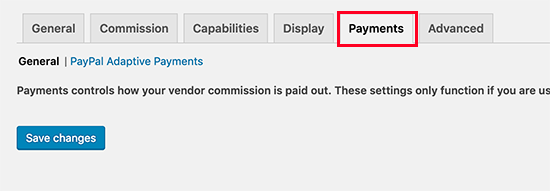
However, if you want a payment withdrawal system for vendors, you can buy premium add-ons. WC Vendors offers add-ons for Stripe, MangoPay, Escrow, and Manual Payouts.
Depending on your payment gateway, you will need to set it up by entering your API keys. Remember to click the ‘Save Changes’ button to store your settings.
Now that WC Vendors is ready, let’s set up WooCommerce for a multi-vendor environment.
Step 3. Enable Account Management in WooCommerce
First, you need to visit the WooCommerce » Settings page and click on the ‘Accounts’ tab.
From here, you need to check the boxes next to the customer registration option.
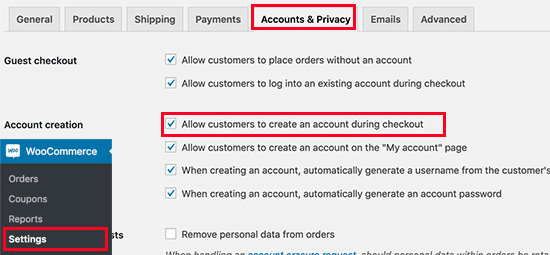
Don’t forget to save your changes.
Step 4. Setting Up Navigation Menus
Now that your multi-vendor marketplace setup is finished, it is time to make it easy for your users to navigate your website.
If you use a block-based WordPress theme, visit the Appearance » Editor page to launch the site editor.
Inside the site editor, click on the ‘Navigation’ menu item and choose the navigation menu to edit. You can also click on the Navigation Menu in the preview window to edit it.
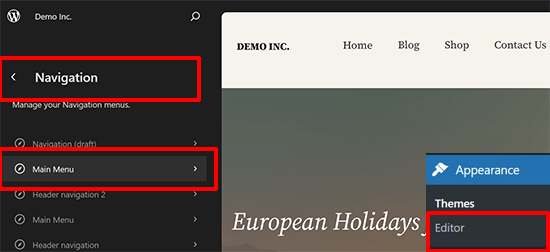
Once you are inside the navigation block, click the add [+] button to add a new menu item.
After that, add a link to the user account page you created earlier.

After that, don’t forget to click the ‘Save’ button to store your changes.
If you use a classic WordPress theme, go to the Appearance » Menus page.
From here, you need to add your user account and checkout pages to the navigation menu.
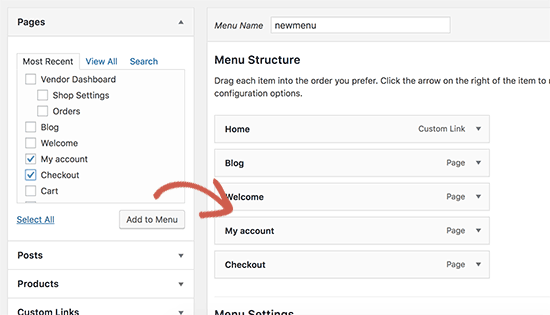
Remember to click the ‘Save Menu’ button to store your changes. For more detailed instructions, see our guide on how to add navigation menus in WordPress.
If you don’t have a My Account page, then create a new page in WordPress and add the following shortcode in the post editor:
[woocommerce_my_account]
Step 5. Testing Your Marketplace Website
Your online marketplace website is now ready for testing.
To do so, visit your website in a new browser window and click on the ‘My Account’ link at the top to create an account.

From here, both customers and vendors can log in to their accounts.
Users can also create a new account and apply to become a vendor.
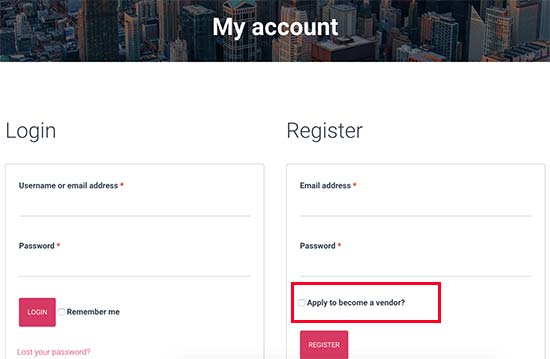
Once users create a new account, you will receive an email notification. If you are unable to receive email notifications, then take a look at our guide on how to fix the WordPress not sending email issue.
You can also view new vendor applications by visiting the Users » All Users page. You will see all new vendor requests as ‘pending vendor,’ and you can approve or deny applications by clicking the link under their username.
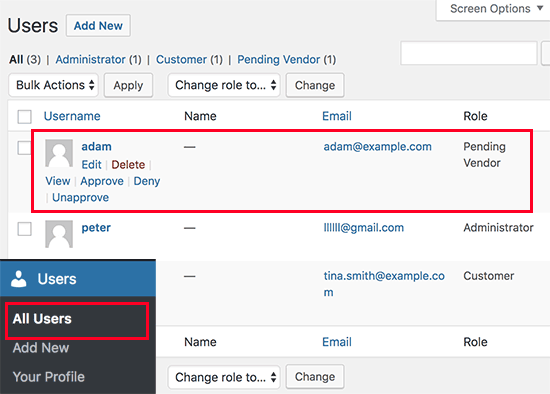
Once approved, these vendors can log in to their accounts and add their products by visiting their vendor dashboard.
They can also view their orders and sales reports.
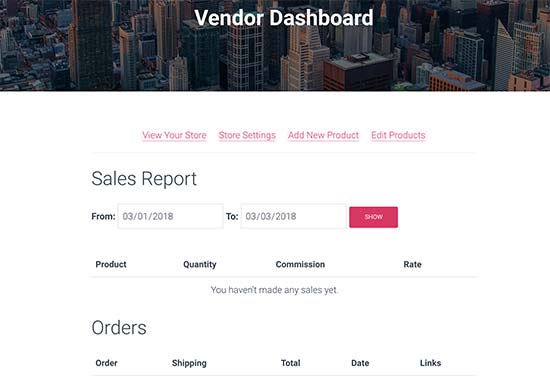
The first thing your vendors need to do is to set up their shop settings.
You can do this by clicking on the ‘Store Settings’ link.
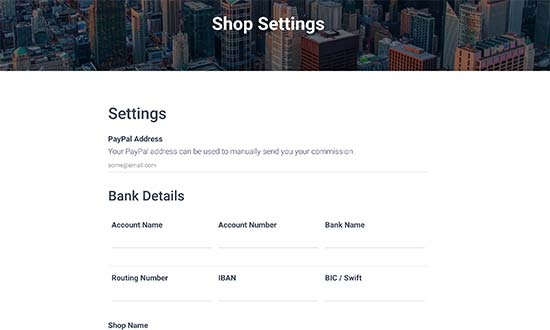
Depending on the payment methods you set up, they will need to provide their PayPal or Stripe email address to receive payments.
They will also be able to provide bank account information for direct manual payments.
Once a vendor adds a new product, you will get a notification email and see an icon next to the products menu. You can then edit a product, approve it, or delete it.
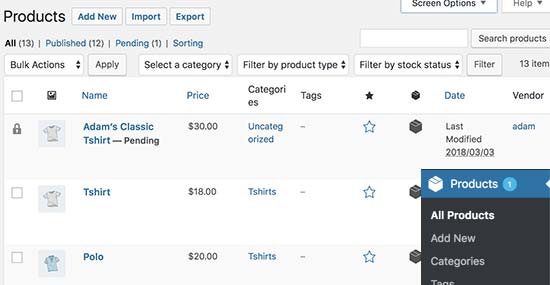
Your shop page will clearly show the products sold by the vendor’s shop name.
You can see an example below.
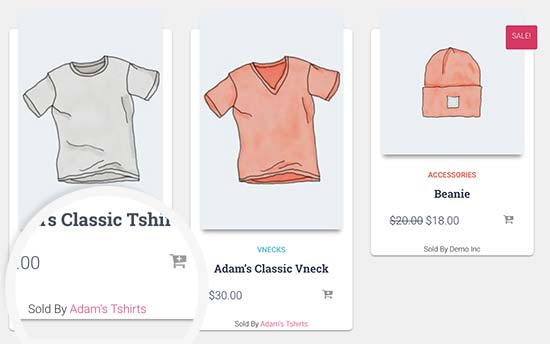
Step 6. Growing Your Online Marketplace Website
Now that your online marketplace platform is ready, here are a few tips on growing it to generate a reliable passive income.
1. Design
First, you may want to choose a design for your marketplace website. WordPress comes with thousands of free and paid themes, but not all of them are eCommerce-ready.
See our pick of the best WooCommerce themes to find a suitable theme for your marketplace platform.
Expert Tip: If you are looking for a completely custom design, then check out the WPBeginner website design services. We can build you a custom WordPress website from scratch, along with optimizations for speed, SEO, and user experience.
2. Add New Features
After that, you will want to add new features to your website. For example, making it a multi-vendor auction site or a membership community.
3. Track Data
You will want to track which products are getting more traffic and which vendors are bringing more users.
To do so, you will need to enable customer tracking in WooCommerce on your website.
4. Boost Sales
The biggest hurdle in growing any eCommerce website is abandoned cart sales. Learn how to recover abandoned cart sales like a pro to increase profits.
We hope this article helped you learn how to create an online marketplace using WordPress. You may also want to see our ultimate eCommerce launch checklist or our expert pick of the most profitable eCommerce business ideas for WordPress.
If you liked this article, then please subscribe to our YouTube Channel for WordPress video tutorials. You can also find us on Twitter and Facebook.





Mrteesurez
This is amazing, the guide is detailed enough and has explained it to be understood specifically for beginners. Only WordPress.org can be used to create a marketplace, like eBay and Amazon. That is why WordPress is powerful. Can you build this type of website on Blogspot, Wix, Medium even Shopify ? No.
Thanks for the guide. I have ebook store already, maybe later I can turn it into marketplace. This guide would be of help for me.
Moinuddin Waheed
Creating a platform like that of eBay and indiamart in India seems very smooth with plugins like wc vendors which gives the flexibility to make a marketplace like that of eBay and others.
However, the tough part starts after making it i.e to promote and marketing as such a platform and gain trusts of the vendors to list their products and sell.
it would be nice if a detailed guide available for marketing the platform as a marketplace as well?
WPBeginner Support
Maybe in the future, it depends on what the marketplace is selling for marketing recommendations to start with. Our guide below can give you some good starting guidelines for marketing your marketplace site:
https://www.wpbeginner.com/beginners-guide/how-to-increase-your-blog-traffic/
Admin
Mrteesurez
Yeah, the guide you have shared is enough to drive massive traffics to any type of website ecommerce and marketplace inclusive. I am looking forward to seeing the updated one with marketing tips.
Thanks.
Dave Maggs
Surely if this is like eBay, the vendors would pay the marketplace commission and not the other way round. As the marketplace owner, the vendors would pay a small percentage of each sale they make, which is what happens on eBay.
WPBeginner Support
This plugin does that, it is simply worded in a reverse way for their settings.
Admin
Yolanda
What if I already have a domain and basic hosting? How to I add SSL certificate and everything else to this hosting? Would I need to upgrade hosting if expecting a lot if traffic/registered customers?
WPBeginner Support
You would want to check with your hosting provider as each has a different system for how to set up certain things as well as traffic requirements.
Admin
SHERYLL
On this guide, it indicates paying Vendor commission. How to do it the other way around? Is there a plugin for Charging Sellers/Vendors a small commission fee each time they sell their item in the Marketplace?
WPBeginner Support
That section is what you’re looking for. The commission determines how much the vendor would be paid and you can set it to have a fee or a commission and fee, or only a fee.
Admin
Tanya
I’m not seeing anything in these instructions that can’t be done on the WordPress.com Business plan. Is there a particular reason why this article suggests that it can’t be done within WordPress.com?
WPBeginner Support
WordPress.com could allow this on their business plan for now but there is no guarantee that it would be allowed or if it is temporarily allowed which is why all of our content is for WordPress.org sites. You can see the differences between WordPress.com and WordPress.org in our article below:
https://www.wpbeginner.com/beginners-guide/self-hosted-wordpress-org-vs-free-wordpress-com-infograph/
Admin
Toby
Amazing article great job!
I’m hoping you can help with this issue?
I just want to receive a small amount of commission on each sale a vendor makes – I don’t want to pay a vendor. Can I do this with these plugins?
WPBeginner Support
From the sound of it, you would want to create an affiliate store similar to our guide below:
https://www.wpbeginner.com/wp-tutorials/how-to-build-an-amazon-affiliate-store-using-wordpress/
Admin
Fab
I am looking to create Customer to Customer (p2P) marketplace. Is the plugin you are recommending for commercial vendor?
WPBeginner Support
You can use this for businesses. If you have a specific use case you’re wondering about, we would recommend reaching out to the plugin’s support and they can let you know what is available.
Admin
Mohammad
Hello thanks for this nice info . But i missed some thing about the creating of My account page then adding the short code ‘woocommerce_my_account’ in the post editor .. Where is the post editor ? i m sorry , i m so new in WordPress
WPBeginner Support
It is the default editor when you open a page to edit, we cover it in our article below:
https://www.wpbeginner.com/beginners-guide/how-to-add-a-new-post-in-wordpress-and-utilize-all-the-features/
Admin
Deepti Upendra
How much would the whole setup cost?
WPBeginner Support
You would want to take a look at our article below for a starting point:
https://www.wpbeginner.com/beginners-guide/ecommerce-website-cost-real-numbers/
Admin
Arihant
Is it true that more I install the WordPress plugins, makes the websites more slow?
WPBeginner Support
For how plugins affect your site, you would want to take a look at our article below:
https://www.wpbeginner.com/opinion/how-many-wordpress-plugins-should-you-install-on-your-site/
Admin
Nils Döhring
Hey WPbeginner Team!
I would like to know if the free version of WC Vendors is enough to accomplish these steps?
Or will I need the paid option?
WPBeginner Support
It would depend on the specifics you’re setting up, the plugin states on its page the features that require pro or not.
Admin
Joao
Hi
is it possible to assign a store page to each seller, where only one seller’s products appear, that is, each seller with their own virtual store within the site?
WPBeginner Support
Yes, you can do this, you would want to reach out to the plugin’s support for the current methods for setting that up.
Admin
Marius Vetrici
What about Split Payments? In some countries, like the US, you have to use Split Payments for legal compliance.
WPBeginner Support
The plugin does have tools for split payments. If you reach out to their support they should let you know the current options available.
Admin
Daniel Forrest
Hello! I’m looking to build a marketplace where I only receive money from a vendor when they make a sale. Will WC Vendors and/or WC allow me to do that? I understood from your article that WC Vendors is not set up in this way.
WPBeginner Support
From what it sounds like you’re wanting WC Vendors should be what you are looking for
Admin
Obarayese Dhikrullah
This is great. We need a review on all the multi-vendor plugins to known which is better. Thanks
WPBeginner Support
Thank you for your recommendation, we will certainly look into the options available.
Admin
An
How many vendors could be allowed when creating website using WordPress?
WPBeginner Support
Unless we hear otherwise, an unlimited number
Admin
S Hassan
Hi
Many thanks for this Amazing article. It is very heloful and inspiring.
I would like to crate a multi-vendor marketplace but without the payment option. On the buy / add to basket button in the product page in my site, the vendors add the link to the product page on their own websiite and then buying and payment happens in the vendor’s site.
Is it the right wordpress template for my site or would you recommend a different one?
Many thanks
Hassan
WPBeginner Support
For what it sounds like you’re wanting, you may want to take a look at: https://www.wpbeginner.com/wp-tutorials/how-to-build-an-amazon-affiliate-store-using-wordpress/
Admin
Ruby Knowles
Hi, is it possible for users to be both buyers and sellers all under one account?
WPBeginner Support
Unless I hear otherwise you should be able to do that
Admin
Solange
Hello,
Thank you so much for this amazing article.
I feel that I am ready to start creating my marketplace website. However, I would like to create it to serve people that do not speak English. Do I have to create it and have a plugin to translate it? I would have to translate it by myself once the language I want to translate is my first language? Or, is this info only possible for English users/speakers?
Thank you in advance,
Solange
WPBeginner Support
You can change the language to the language you want your site to be and shouldn’t have any issues
Admin
Carole
Hello. I am wanting to set up an online marketplace. I read this article which is really helpful but as far as payments go, I don’t want to take or charge a commission. Is there any Wordpress plugin or theme I could use that would allow me to take an annual fee from the sellers and add give them the ability to link PayPal to their own pages so customers can pay them directly? A bit like Amazon etc. Thanks.
WPBeginner Support
You may want to reach out to WC Vendors to see about options available for that
Admin
Tafida
Please I will like to know how much in dollars currency it will approximately cost me to build a good market place from scratch to finish. I want to do it myself without hiring and developer. Thank you very much
WPBeginner Support
For understanding the costs, you would want to take a look at our article here: https://www.wpbeginner.com/beginners-guide/how-much-does-it-cost-to-build-a-wordpress-website/
Admin
FATIMA
HI,
Great article, thank you !
I want to create a market place without payment ( put service users and providers in contact with each other for free) and i want to know if this platform is suitable for my needs.
Please help me, I am beginner !
Thanfs
WPBeginner Support
For what it sounds like you’re wanting, you would want to take a look at a business directory plugin: https://www.wpbeginner.com/plugins/best-directory-plugins-for-wordpress/
Admin
Jamie
Hi There,
Thanks for the great writeup of our plugin. We are continually adding new features and pride ourselves on timely support for all our users free and pro. We are in the planning stages of some major changes to our product to make it even better! If you have any questions please do not hesitate to contact us through our website or on the WordPress.org forums.
cheers,
Jamie
Founder, Lead Developer
WC Vendors Marketplace
Ann
Hi, Thank you for this post. I am having issues with setting up my marketplace. The vendor registration seems to be missing on the account page. Is there a way to fix this?
Thanks
WPBeginner Support
If you’ve enabled it in the options then you may want to reach out to the WC Vendors support to ensure there isn’t an error with the plugin and they should be able to assist.
Admin
Steve B
Is there a way for a visitor/customer to post a request on my marketplace? Example: looking for a used Gibson Les Paul. And then the vendors could get notified when there’s a request posted in their chosen category?
WPBeginner Support
For that, you would need another plugin or tool for it to be available
Admin
Bruno
Is it possible to apply a fee when the item is buyed thru this plugin?
WPBeginner Support
It would depend on the type of fee you’re attempting to add. If you reach out to WooCommerce’s support with the specific setup you’re wanting they should be able to let you know
Admin
Shahzaib Majeed
Thank you for the beautiful info i have created my site by using your post.
WPBeginner Support
Glad our guide could help
Admin
Mahmoud Mirzaei
Hi,
I am after a professionally designed marketplace and want to invest big money on it. I want a marketplace just like branded ecommerce marketplaces.
Will the outcome be like them or I will need to hire someone to code it down?
thanks,
WPBeginner Support
It would depend on how much customization you’re wanting for your site for if you’d need help from a developer.
Admin
Patrick
Thanks a lot for this helpful post! I followed these steps. One question, in the “My Account” page on the right side under “Register” I can tick two checkboxes both of which say “undefined”. Where do I define these?
Thank you in advance!
WPBeginner Support
That should be defined by the plugin, if you reach out to the plugin’s support they should be able to help fix the issue.
Admin
Wasim Akram
Great Advice, Thanks
WPBeginner Support
You’re welcome
Admin
Dennis
Hi WPbeginner, how do the vendors get all the product and shipping information of the products bought? afterall, it isup to them to do the fullfilment including shipping. Is that via the paypal checkout where this information is being sent?
kind regards
Dennis
WPBeginner Support
The plugin has a few shipping options that you can allow for the vendors, if you reach out to the plugin’s support they will let you know what options are available.
Admin
Antonio Ramos
I installed wc vendors, I followed the steps for its configuration, but it is not shown as a submenu item in the woocommerce menu. How can i fix this?
Gregory
I tried to plug in WC Vendors
But then I get a page that says “The plugin does not have a valid header.”
WPBeginner Support
Hi Gregory,
Try deleting and then reinstalling the plugin.
Admin
Gregory
Also theres nothing that says just WC Vendors,
The plugins say WC Vendors Marketplace and WooCommerce Multi Vendor Marketplace
WPBeginner Support
Hey Gregory,
WC Vendors Marketplace is the plugin.
Admin
Charles Oma
Great post. I would like to build a marketplace using this set up. But due to my location and for business reasons, I have a particular payment gateway I intend to use. They already have a plugin for woocommerce. Is it possible to build a marketplace using this set up with my preferred payment gateway? I’m asking because I don’t understand your response to Fatima where you said “WooCommerce supports many payment gateways. However, WC Vendors uses PayPal Adaptive Payments and Stripe”.
WPBeginner Support
Hi Charles,
WooCommerce can be used with dozens of payment providers. However, WC Vendors only supports these two payment options to payout vendors.
Admin
Daniellah KACHAU
After reading am very interested with Online Marketplace.
I want to set up a Online Marketplace for Pharmacy Retailers and Medical Supplies Wholesalers in my country Papua New Guinea.
I want you HELP me set this up.
How will I pay you for that service if you willing to help me in detail set up my Online Marketplace.
WPBeginner Support
Hi Daniellah,
We do not offer consultancy services. If you want to hire someone to help you out, then you can look for a freelance developer on one of the popular freelancing websites like UpWork or Freelancer.
Admin
Sam
Hi,
Thanks for the article,
Is it posible to charge the vendor per product listing and a percentage of the sale value? i.e. like ebay
Many thanks
Sam
Kyeremeh
Please do we have a free domain and hosting at blue host
Anh Binh
Hello,
I would like to build marketplace in loan industry to connect lender and borrower ( some kind of peer to peer lending but I don’t call money from lender, just want to connect both of them) and I will collect the fee from lender for each borrower successfully connected (fee will be collected via local bank account not paypal). What is the theme or plugin I should use for this case? Of course I will use bluehost registered through your link for domain and hosting as their price is reasonable
Palash
I have an question . I have a marketplace If i use this plugin and vendor start to upload products then those product will be go product page or i should make some others page for it ?
Fatima
Please guide me. Can we use other payment methods other than PayPal, coz we don’t have PayPal services here in Pakistan.
WPBeginner Support
Hi Fatima,
WooCommerce supports many payment gateways. However, WC Vendors uses PayPal Adaptive Payments and Stripe.
Admin
Muhammad Ahtisham Ali
Is it reliable to use WordPress for building multi vendor website? I have heard that WordPress is very heavy specially when it comes to building multi vendor marketplace, it takes very much time to load. Is that the case ? What should we do if that’s the case
WPBeginner Support
Hello,
As your website grows you will be able to generate enough revenue to upgrade your hosting plan.
Admin
Sravya
Hello ,
Thanks a ton for the info.
I have a question . I want to start a online market , and I don’t want to sell my products I want to sell others like amazon in my page . So while setting up do I need to put my products list or is their any way that the page can redirect to amazon. Because I saw in setting up their is a page which showed to uplaload a photo of the product which I don’t have .
Punit Bhandari
This post was quite helpful. I was wondering which Indian payment gateway supports multi-vendor payments. Do you recommend any? None of their website’s mention this feature.
David
Can vendors add products via the frontend?
Nhung
Which marketplace theme did you use?
WPBeginner Support
Hi Nhung,
For this tutorial we created a demo site and used a free WordPress theme called Hestia.
Admin
Mikael Andersen
I have a question about the hosting provider. You recommend Blue Host, but in the last couple of weeks I have several times read that Siteground should be at better hosting company, and that WordPress.org recommend using Siteground.
Could you explain if there are any different features for those two hosting providers.
dmsumon
They are recommending “Blue Host” only because WPBeginner is a partner of Blue Host and in the article they are using a referral link. Siteground is one of the best shared WP hosting out in the web and on the other hand they are a little expensive too comparing to other shared WP hosting. Blue Host is also a good choice if you are tight on budget as well as need performance.
Mikael Andersen
OK – Thank you for your answer
WPBeginner Support
Hey Mikael and dmsumon,
We recommend Bluehost because we have used them and we believe they are the best hosting company for WordPress beginners. We do get a small cut when users sign up at no extra cost to the user. Please see our disclosure page for more details.
We also recommend SiteGround for growing websites. See our list of WordPress hosting providers that we trust and recommend.
Admin